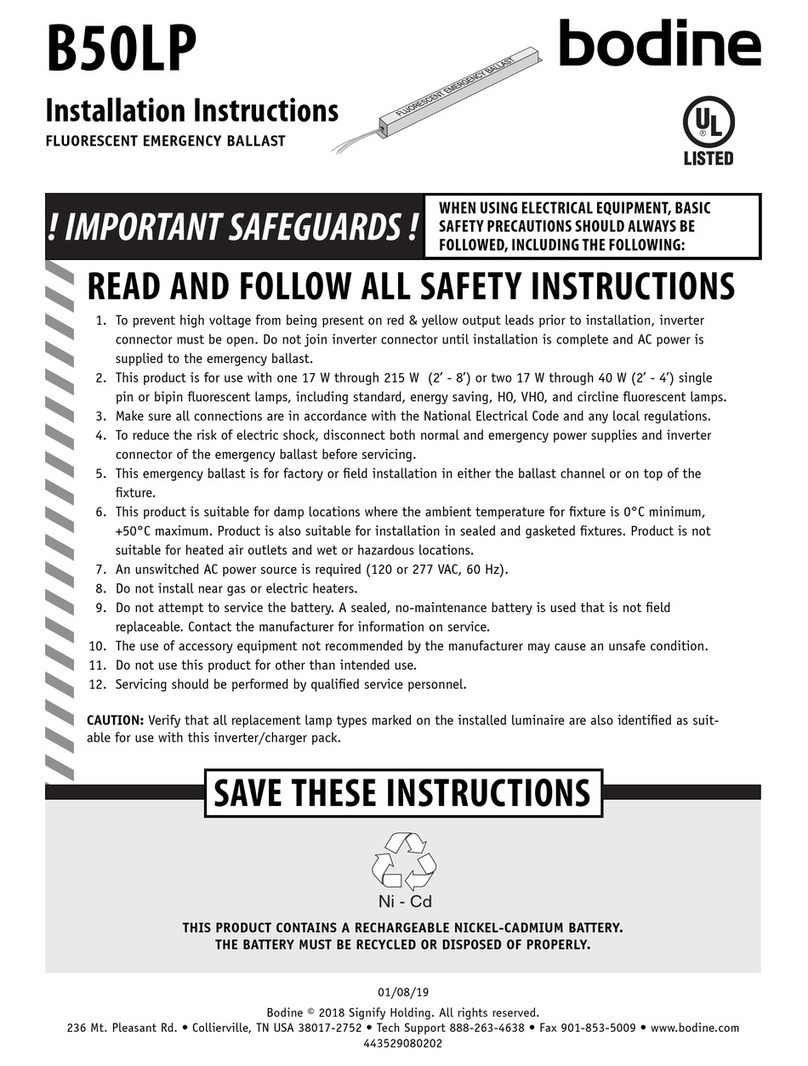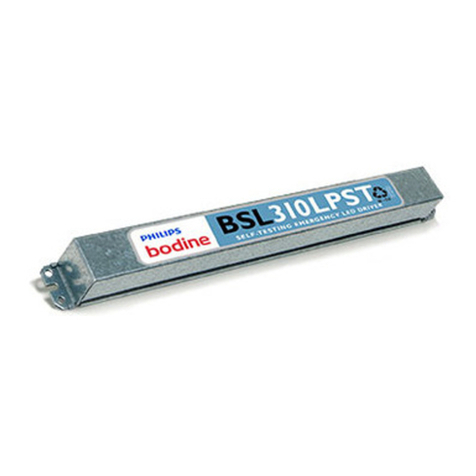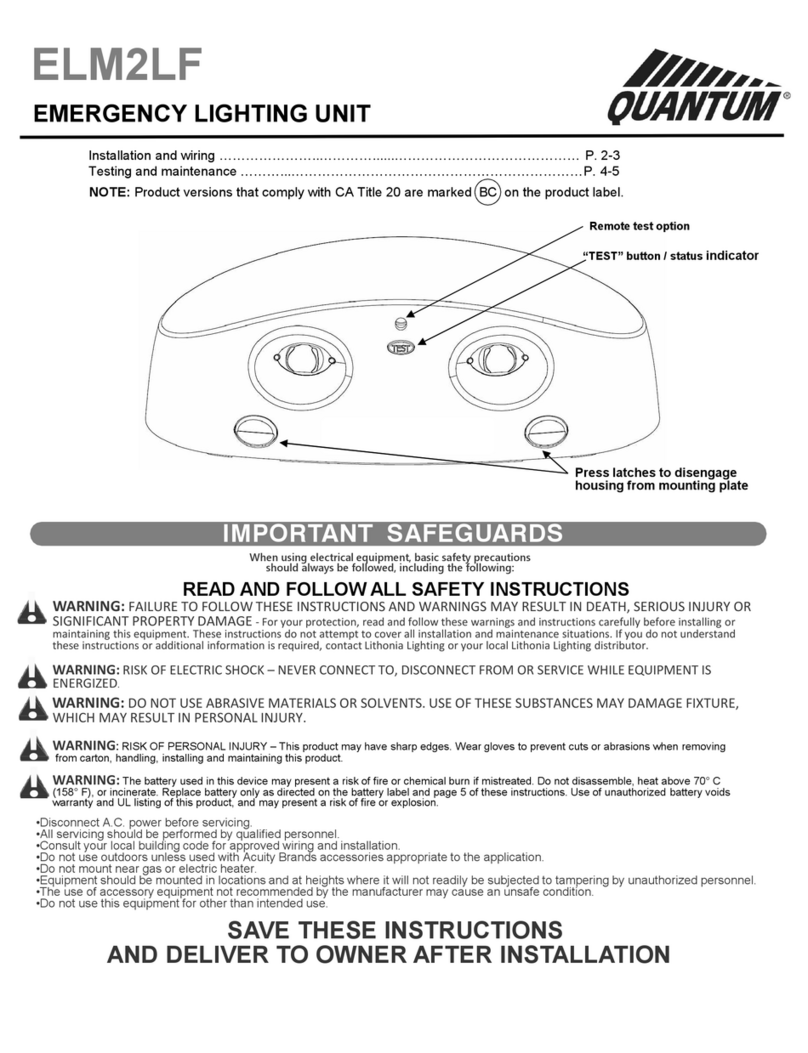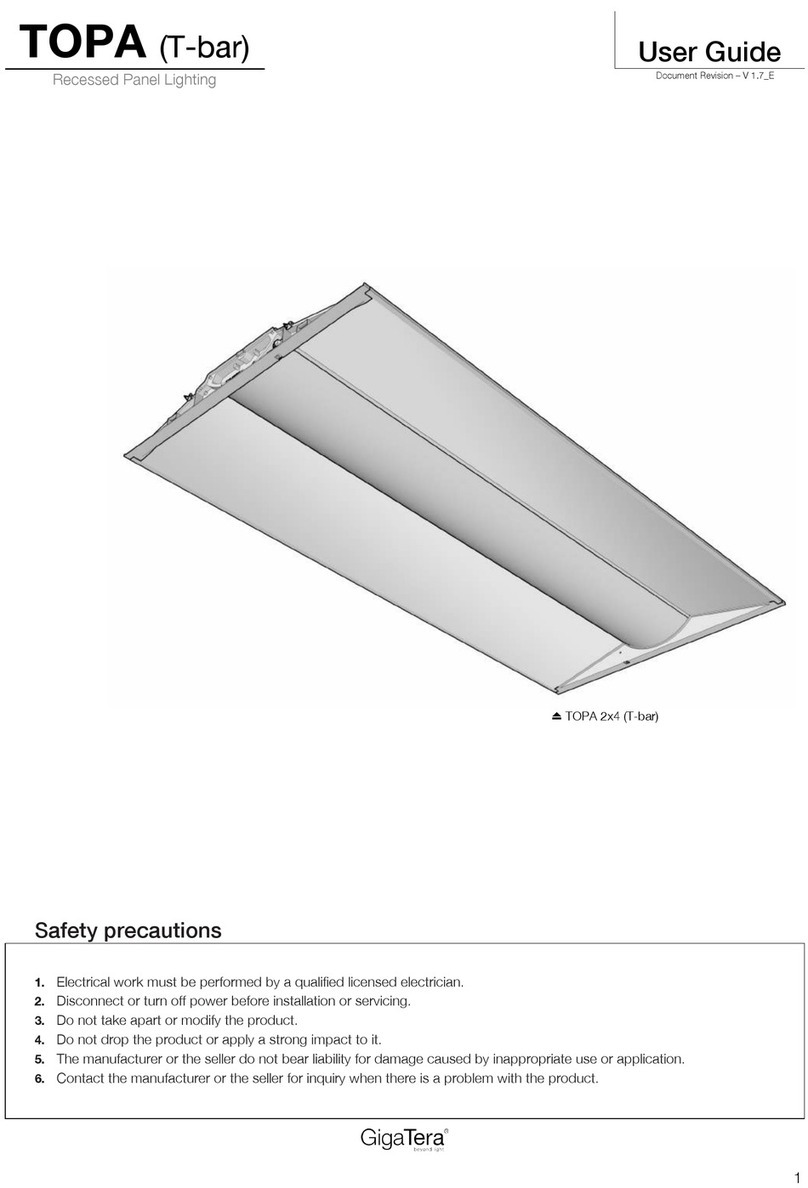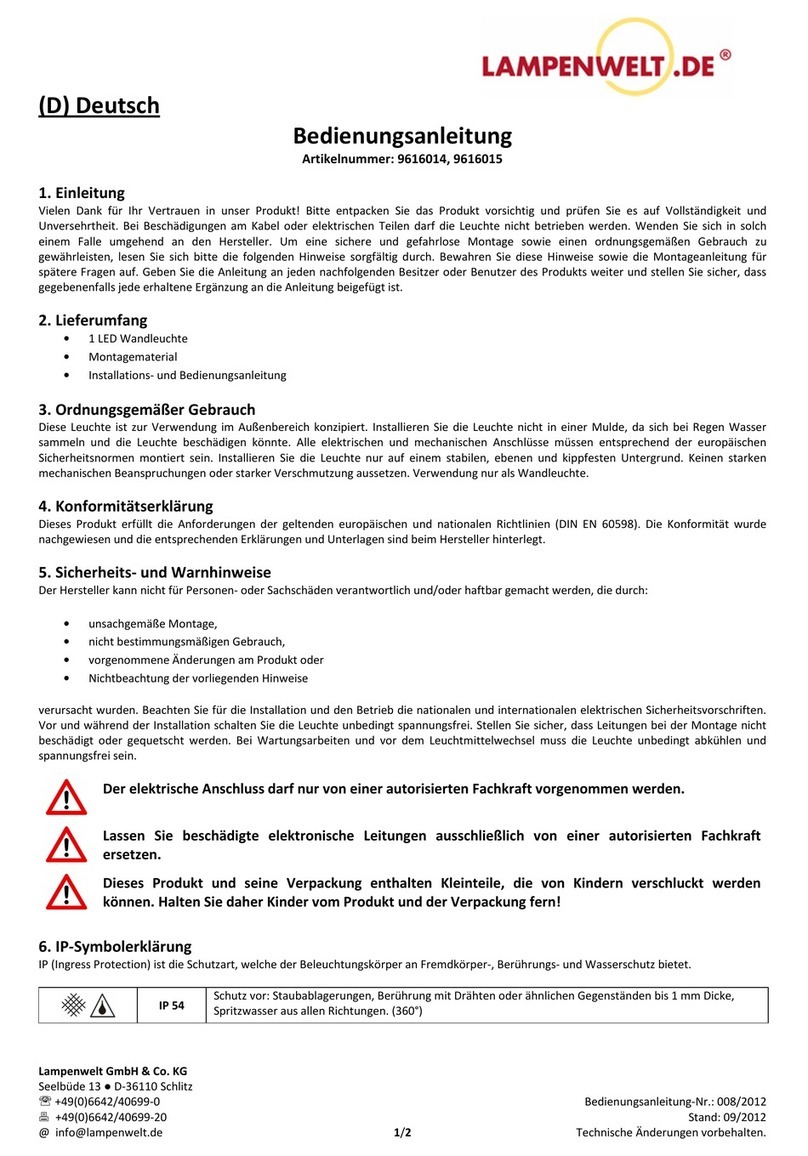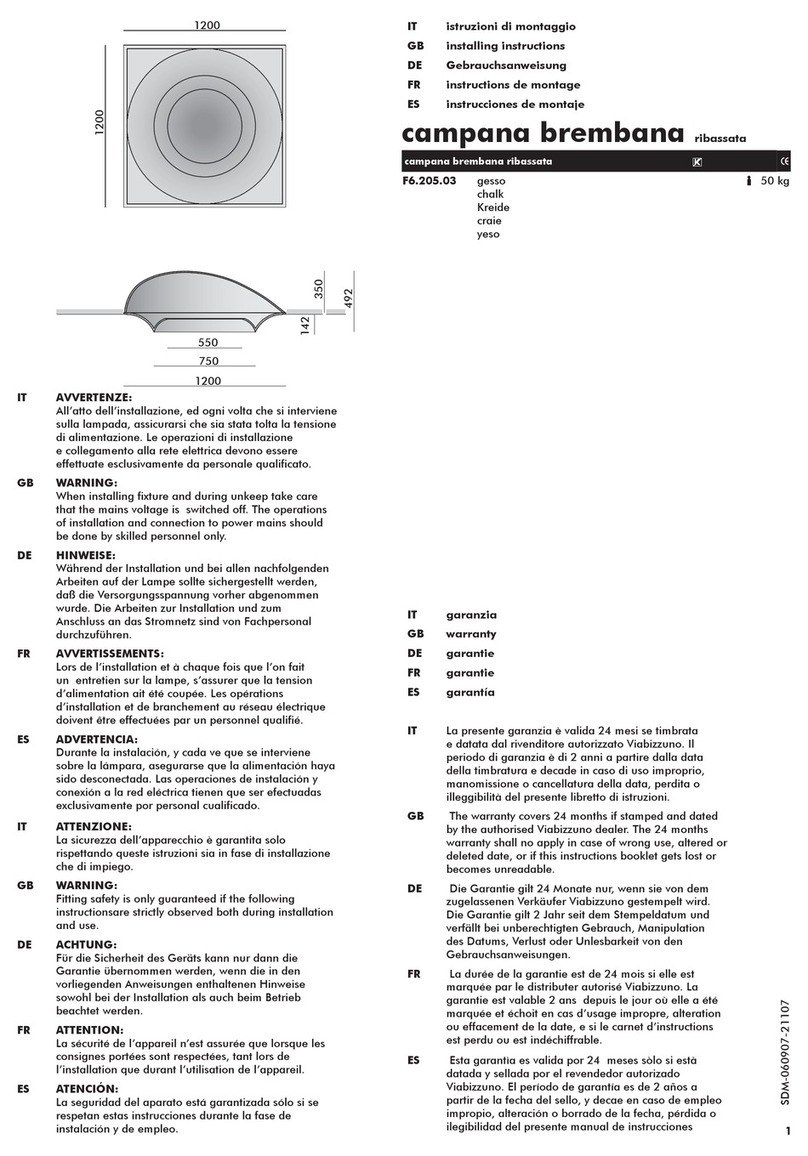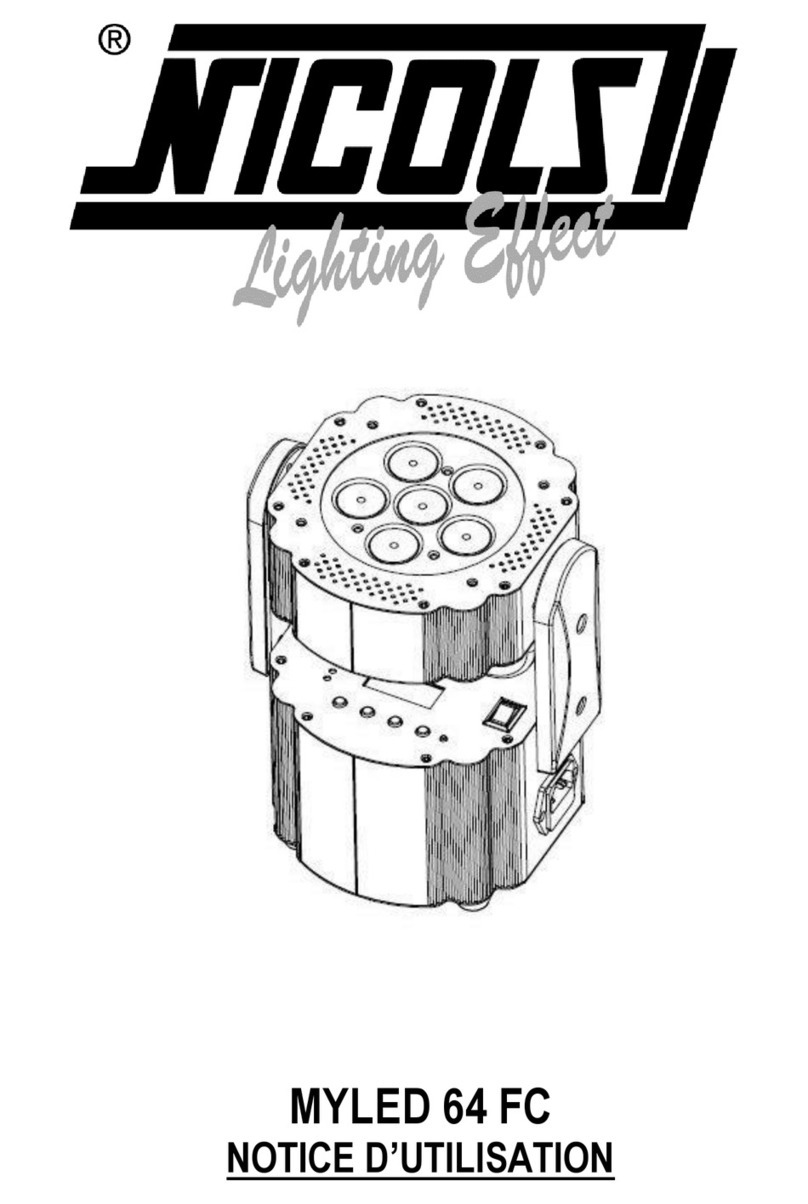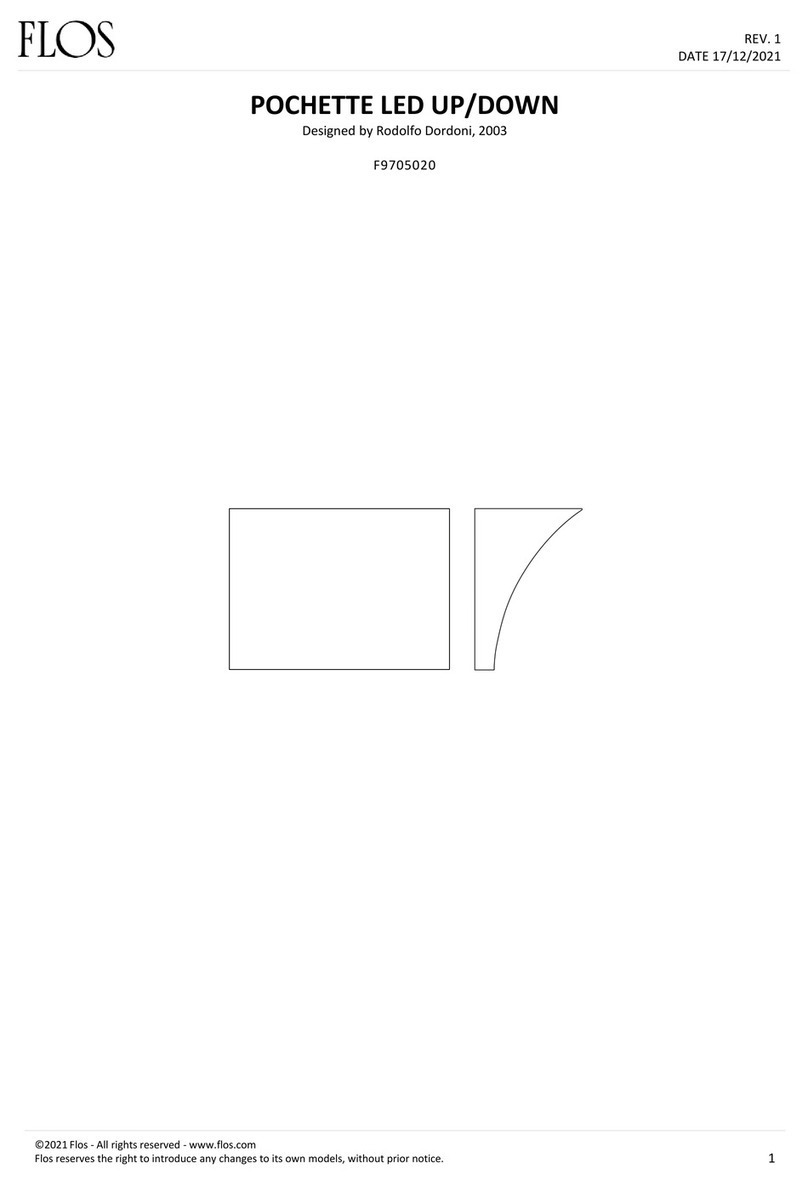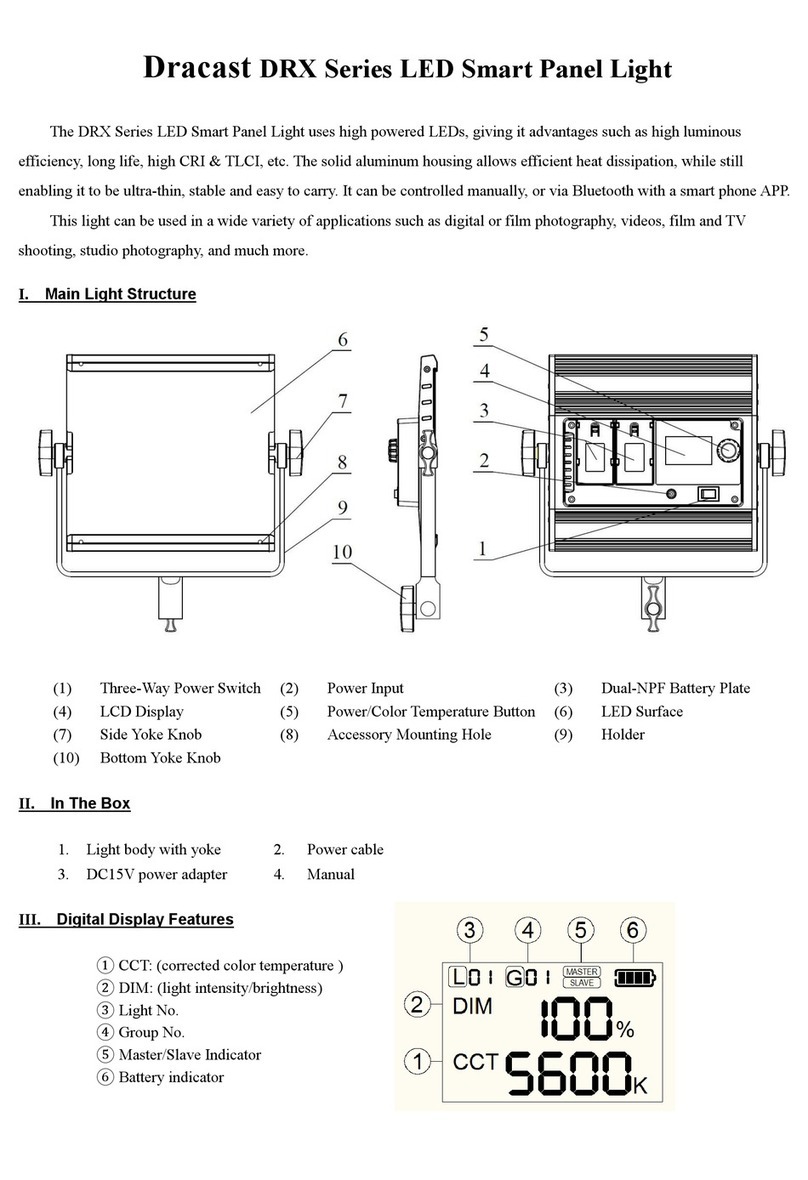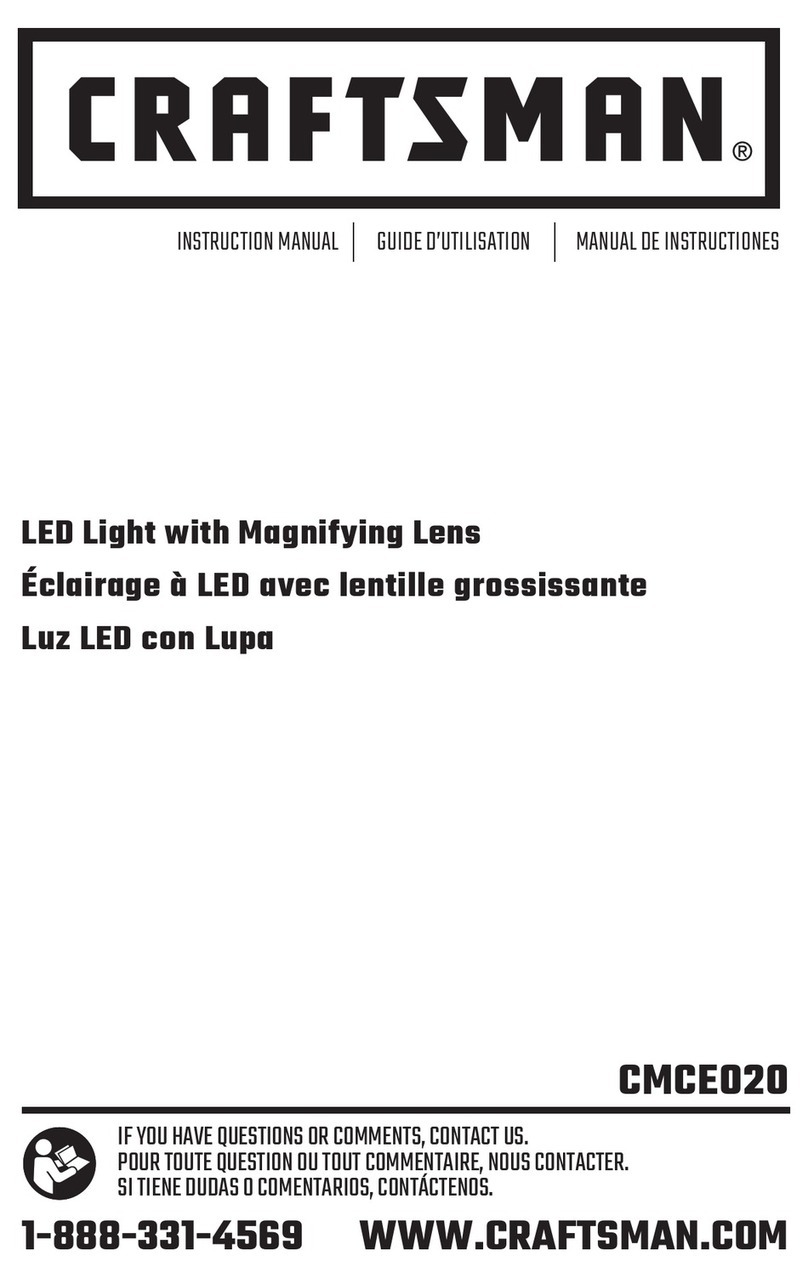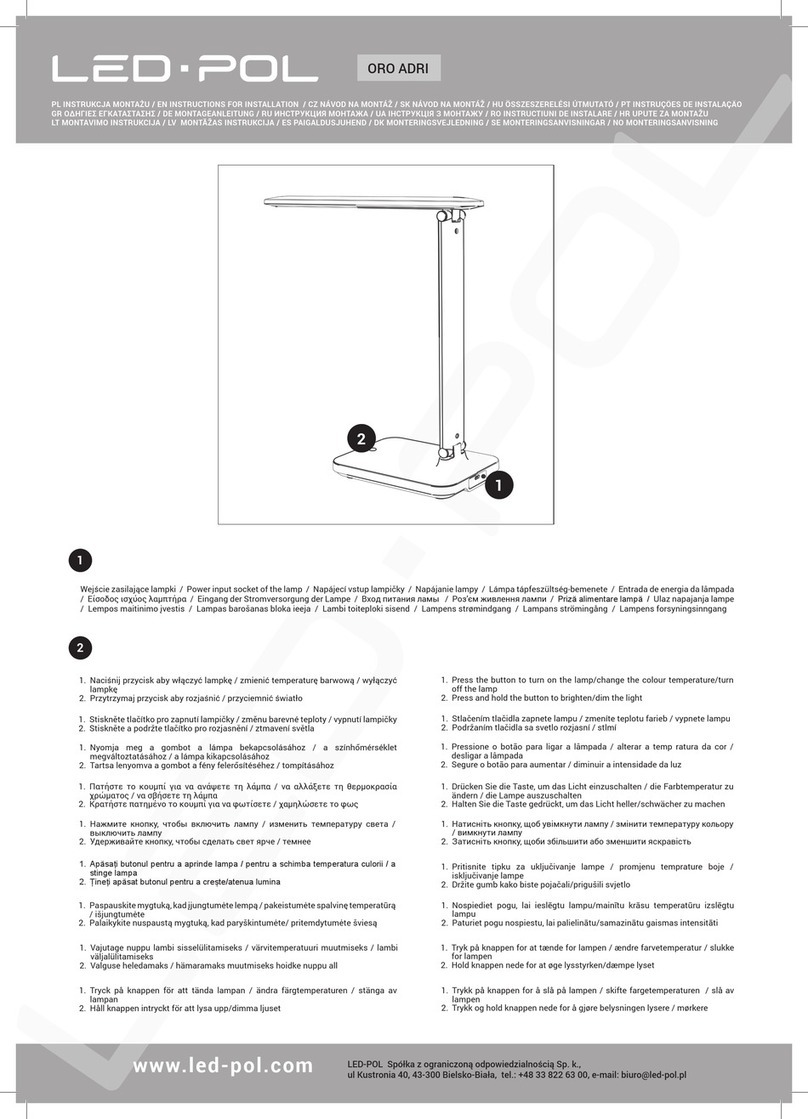Bodine CF94 User manual

READ AND FOLLOW ALL SAFETY INSTRUCTIONS
! IMPORTANT SAFEGUARDS ! WHEN USING ELECTRICAL EQUIPMENT, BASIC
SAFETY PRECAUTIONS SHOULD ALWAYS BE
FOLLOWED, INCLUDING THE FOLLOWING:
SAVE THESE INSTRUCTIONS
THIS PRODUCT CONTAINS A RECHARGEABLE NICKEL-CADMIUM BATTERY.
THE BATTERY MUST BE RECYCLED OR DISPOSED OF PROPERLY.
© Philips Emergency Lighting
A Division of Philips Electronics North America Corporation
236 Mt. Pleasant Rd. • Collierville, TN USA 38017-2752 • Tech Support 888-263-4638 • Fax 901-854-1630 • www.philips.com/bodine
70094006
Installation Instructions
1. To prevent high voltage from being present on red & yellow output leads prior to installation, inverter
connector must be open. Do not join inverter connector until installation is complete and AC power is
supplied to the emergency ballast.
2. This product is for use with one 13 W - 42 W or two 13 W - 39 W (4-pin) compact fluorescent lamps without
integral starters.
3. The emergency ballast must be connected to an unswitched AC power source (120 or 277 VAC, 60 Hz).
4. When installing the emergency ballast, make sure all connections are in accordance with the National
Electrical Code and any local regulations.
5. To reduce the risk of electric shock, disconnect both normal and emergency power supplies and inverter
connector of emergency ballast before servicing.
6. This product is for use with indoor fixtures except air handling heated air outlets, and wet, damp, or
hazardous locations.
7. Do not attempt to service the battery. The emergency ballast uses a sealed, no–maintenance battery.
Contact the manufacturer for information on service.
8. The use of accessory equipment not recommended by the manufacturer may cause an unsafe condition.
9. Do not install near gas or electric heaters.
10. Servicing should be performed by qualified service personnel.
11. Do not use this equipment for other than intended use.
CF94
Ni - Cd
EMERGENCY LIGHTING EQUIPMENT
04/06/11

STEP #1 INSTALLING THE EMERGENCY BALLAST
> Mount the emergency ballast and battery inside the fixture.
STEP #2 INSTALLING THE TEST SWITCH
> Install the test switch on the fixture so it can be accessed after
fixture installation.
> See illustration below showing basic switched and unswitched
fixture connections for test switch installation. Refer to the
diagrams and wire the test switch so that it removes AC power
from both the emergency ballast and the AC ballast at the same time.
> Drill a 1/2" hole and install the switch as shown.
STEP #3
STEP 1 STEP 2
NOTE: After installing the charging indicator light and test switch, mark each with the appropriate label.
> Install the CHARGING INDICATOR LIGHT
as shown in the illustration so it will be
visible after the fixture is installed.
INSTALLING THE CHARGING INDICATOR LIGHT
NOTE: Make sure that the necessary branch circuit wiring is available. An unswitched
source of power is required. The emergency ballast must be fed from the same
branch circuit as the AC ballast.
WARNINGS:
1. TO PREVENT DAMAGE TO THE EMERGENCY BALLAST, JOIN THE BATTERY CONNEC-
TOR BEFORE SUPPLYING AC POWER TO THE EMERGENCY BALLAST.
2. TO PREVENT HIGH VOLTAGE FROM BEING PRESENT ON RED & YELLOW OUTPUT
LEADS PRIOR TO INSTALLATION, INVERTER CONNECTOR MUST BE OPEN. DO NOT JOIN
INVERTER CONNECTOR UNTIL INSTALLATION IS COMPLETE AND AC POWER IS
SUPPLIED TO THE EMERGENCY BALLAST.
Fixture
Test Button
Hex Nut
Hex Nut
Test Switch
Leads
Push to Test
INSTALLATION
Charging
Indicator
Light
1/2" White
Bushing
Violet (+)
Brown (–)
Violet (+)
Brown (–)
1/2" White
Bushing
5/8" Black
Bushing
5/8" Black
Bushing
1/2" Punch
Fixture Fixture
Charging
Indicator
Light
2

When AC power is applied, the charging indicator light is illuminated, indicating the battery is being charged. When
power fails,the emergency ballast automatically switches to emergency power, operating one lamp at reduced
illumination. When AC power is restored, the emergency ballast returns to the charging mode and delays AC ballast
operation for five seconds to prevent false-tripping of AC ballast (end-of-lamp-life) shutdown circuits. This emergency
ballast will operate 13 W through 42 W lamps for a minimum of 90 minutes.
Although no routine maintenance is required to keep the emergency ballast functional, it should be checked
periodically to ensure that it is working. The following schedule is recommended:
1. Visually inspect the charging indicator light monthly. It should be illuminated.
2. Test the emergency operation of the fixture at 30-day intervals for a minimum of 30 seconds. One or two
lamps should operate at reduced illumination.
3. Conduct a 90-minute discharge test once a year. One or two lamps should operate at reduced illumination for
at least 90 minutes.
! REFER ANY SERVICING INDICATED BY THESE CHECKS TO QUALIFIED PERSONNEL !
WIRING THE EMERGENCY BALLAST
> Determine the type of AC ballast installed in the fixture.
> Select the appropriate wiring diagram to connect the emergency ballast to the AC ballast and lamp.
> See back page for more detailed wiring schematics. The emergency ballast can be used with multi-lamp
fixtures. It operates one or two lamps in the emergency mode.
> On switched fixtures, an additional unswitched hot (120 or 277 VAC) lead must be connected to the
emergency ballast.
> The emergency ballast must be connected to an unswitched 120 or 277 VAC power source. Do not connect to other
voltages. After fixture installation is complete:
A. Join the battery connector.
B. Supply AC power to the emergency ballast.
C. Join inverter connector.
> For short-term testing of the emergency ballast, the battery must be charged for at least one hour. The
emergency ballast must be charged for at least 24 hours before conducting a long-term test.
Refer to OPERATION.
> In a readily visible location, attach the label "CAUTION - This Unit Has More Than One Power Supply
Connection Point. To Reduce The Risk Of Electric Shock, Disconnect Both The Branch Circuit-Breakers Or
Fuses And Emergency Power Supplies Before Servicing."
STEP #4
OPERATION
MAINTENANCE
INSTALLATION
3

FIG A ONE (1) LAMP CIRCLINE RAPID START BALLAST FIG B TWO (2) LAMP CIRCLINE RAPID START BALLAST
FIG C ONE (1) FOUR PIN COMPACT LAMP RAPID START BALLAST
FIG E TWO (2) FOUR PIN COMPACT LAMP RAPID START BALLAST
FIG F ONE (1) FOUR PIN COMPACT LAMP WITHOUT AC BALLAST FIG G TWO (2) FOUR PIN COMPACT LAMPS WITHOUT AC BALLAST
(Two lamp emergency operation for 4-pin compact lamps up to 39 W )
FIG D TWO (2) FOUR PIN COMPACT LAMP RAPID START BALLAST
WIRING DIAGRAM for Emergency-Only xtures
EMERGENCY BALLAST AND AC BALLAST MUST BE FED FROM THE SAME BRANCH CIRCUIT
TYPICAL SCHEMATICS ONLY. MAY BE USED WITH OTHER BALLASTS. CONSULT THE FACTORY FOR OTHER WIRING DIAGRAMS.
EMERGENCY BALLAST AND AC BALLAST MUST BE FED FROM THE SAME BRANCH CIRCUIT
TYPICAL SCHEMATICS ONLY. MAY BE USED WITH OTHER BALLASTS. CONSULT THE FACTORY FOR OTHER WIRING DIAGRAMS.
WIRING DIAGRAMS FOR 2-LAMP EMERGENCY OPERATION
WIRING DIAGRAMS FOR 1-LAMP EMERGENCY OPERATION
DO NOT USE TWO-LAMP EMERGENCY WIRING DIAGRAMS FOR ALL UNIVERSAL 4-PIN COMPACT FLUORESCENT
BALLASTS. THESE BALLASTS ARE NOT COMPATIBLE FOR TWO-LAMP EMERGENCY OPERATION.
CAUTION:
DO NOT USE TWO-LAMP EMERGENCY WIRING DIAGRAMS FOR ALL UNIVERSAL 4-PIN COMPACT FLUORESCENT
BALLASTS. THESE BALLASTS ARE NOT COMPATIBLE FOR TWO-LAMP EMERGENCY OPERATION.
CAUTION:
1 LAMP
CIRCLINE
BALLAST
COM WHITE
BLUE
RED
LAMP
RED BLUE
BLU/WHT
YELL/BLK
YELLOW
RED
BLACK
WHT/BLK
INVERTER
CONNECTOR
EMERGENCY
BALLAST
RED WHITE
USE PROPER TAP
CAP UNUSED LEAD
ORANGE
BLACK
WHITE
277V
120V
VIOLET
BROWN
RED
WHITE
BATTERY
CONNECTOR
BATTERY
CHARGING
INDICATOR
LIGHT
WHT/RED
HOT
TEST
SWITCH
BLK BLK
WALL
SWITCH
COM WHITE
RED
RED
BLUE
BLU/WHT
YELL/BLK
YELLOW
BLUE
RED
WHITE
RED
BLUE
WHITE
RED
2 LAMP
CIRCLINE
BALLAST
22 WATT
LAMP
32 WATT
LAMP
(EMERGENCY)
BLACK
WHT/BLK
INVERTER
CONNECTOR
EMERGENCY
BALLAST
RED WHITE
USE PROPER TAP
CAP UNUSED LEAD
ORANGE
BLACK
WHITE
277V
120V
VIOLET
BROWN
RED
WHITE
BATTERY
CONNECTOR
BATTERY
CHARGING
INDICATOR
LIGHT
WHT/RED
HOT
TEST
SWITCH
BLK BLK
WALL
SWITCH
1 LAMP
RAPID START
BALLAST
BLACK
WHITE
BLUE
BLUE
BLUE
YELL/BLK
YELLOW
RED
RED
RED
BLU/WHT
LAMP
COM
WHT/BLK
INVERTER
CONNECTOR
EMERGENCY
BALLAST
RED WHITE
USE PROPER TAP
CAP UNUSED LEAD
ORANGE
BLACK
WHITE
277V
120V
VIOLET
BROWN
RED
WHITE
BATTERY
CONNECTOR
BATTERY
CHARGING
INDICATOR
LIGHT
WHT/RED
HOT
TEST
SWITCH
BLK BLK
WALL
SWITCH
BLACK
WHITE
BLUE
BLUE
BLUE
BLU/WHT
YELL/BLK
YELLOW
YELLOW
YELLOW RED
RED
RED
LAMP 1
2 LAMP
RAPID START
BALLAST
LAMP 2 (
E
MERGENCY)
COM
WHT/BLK
INVERTER
CONNECTOR
EMERGENCY
BALLAST
RED WHITE
USE PROPER TAP
CAP UNUSED LEAD
ORANGE
BLACK
WHITE
277V
120V
VIOLET
BROWN
RED
WHITE
BATTERY
CONNECTOR
BATTERY
CHARGING
INDICATOR
LIGHT
WHT/RED
HOT
TEST
SWITCH
BLK BLK
WALL
SWITCH
BLACK
WHITE
BLUE
BLUE
BLUE
BLU/WHT
YELL/BLK
YELLOW
YELLOW
YELLOW
RED
RED
RED
LAMP 1
2 LAMP
RAPID START
BALLAST
LAMP 2
COM
WHT/BLK
INVERTER
CONNECTOR
EMERGENCY
BALLAST
RED WHITE
USE PROPER TAP
CAP UNUSED LEAD
ORANGE
BLACK
WHITE
277V
120V
VIOLET
BROWN
RED
WHITE
BATTERY
CONNECTOR
BATTERY
CHARGING
INDICATOR
LIGHT
WHT/RED
HOT
TEST
SWITCH
BLK BLK
WALL
SWITCH
BLUE
CAP
CAP BLU/WHT
YELL/BLK
YELLOW
RED
LAMP
INVERTER
CONNECTOR
EMERGENCY
BALLAST
RED WHITE
USE PROPER TAP
CAP UNUSED LEAD
ORANGE
BLACK
WHITE
277V
120V
VIOLET
BROWN
RED
WHITE
BATTERY
CONNECTOR
BATTERY
CHARGING
INDICATOR
LIGHT
TEST
SWITCH
BLK BLK
WHT/BLK
WHT/RED
CAP
CAP
BLUE
CAP
CAP BLU/WHT
YELL/BLK
YELLOW
RED
LAMP
INVERTER
CONNECTOR
EMERGENCY
BALLAST
LAMP
RED WHITE
USE PROPER TAP
CAP UNUSED LEAD
ORANGE
BLACK
WHITE
277V
120V
VIOLET
BROWN
RED
WHITE
BATTERY
CONNECTOR
BATTERY
CHARGING
INDICATOR
LIGHT
TEST
SWITCH
BLK BLK
WHT/BLK
WHT/RED
CAP
CAP
4
Table of contents
Other Bodine Lighting Equipment manuals
Popular Lighting Equipment manuals by other brands
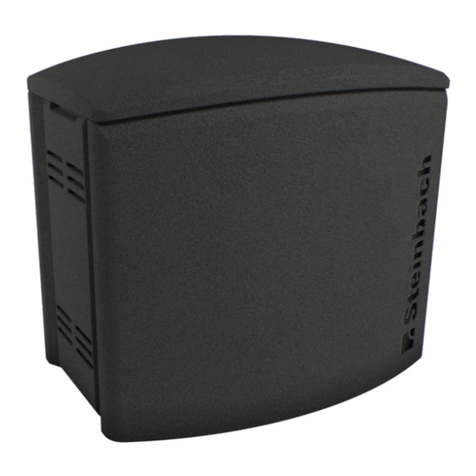
Steinbach
Steinbach 036600 ORIGINAL OWNER'S MANUAL
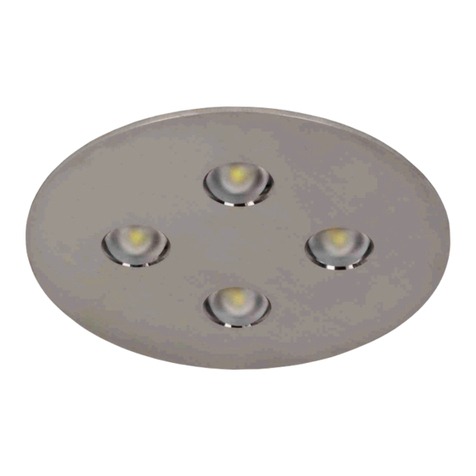
Eaton
Eaton CEAG 3503.1 SL CG-S Mounting and operating instructions
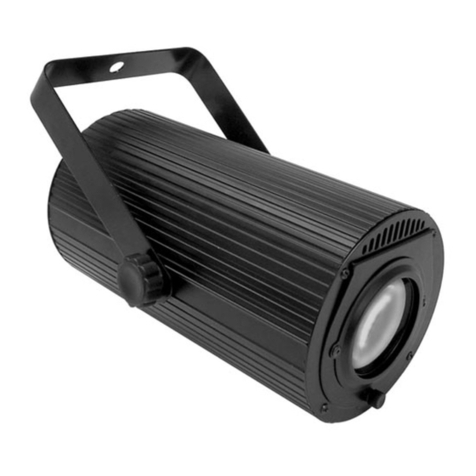
Velleman
Velleman HQ-Power VDL50CM user manual

Nice
Nice TTDRGB Instructions and warnings for installation and use
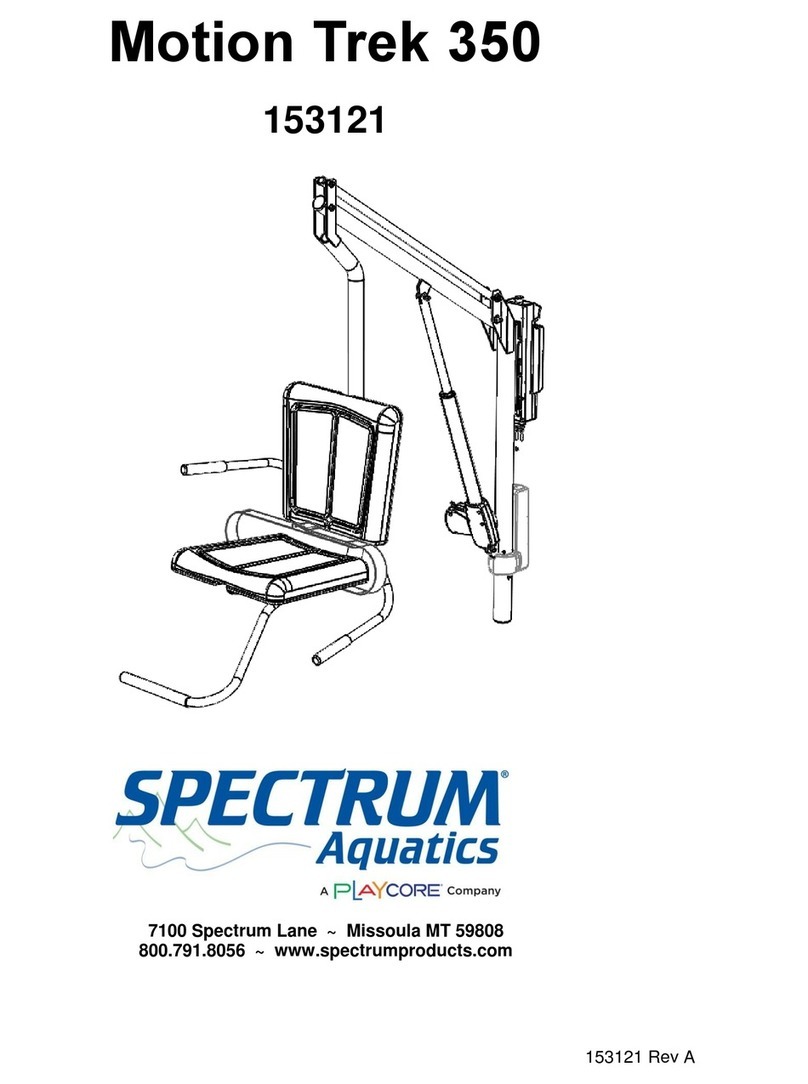
Playcore
Playcore Spectrum Aquatics Motion Trek 350 manual
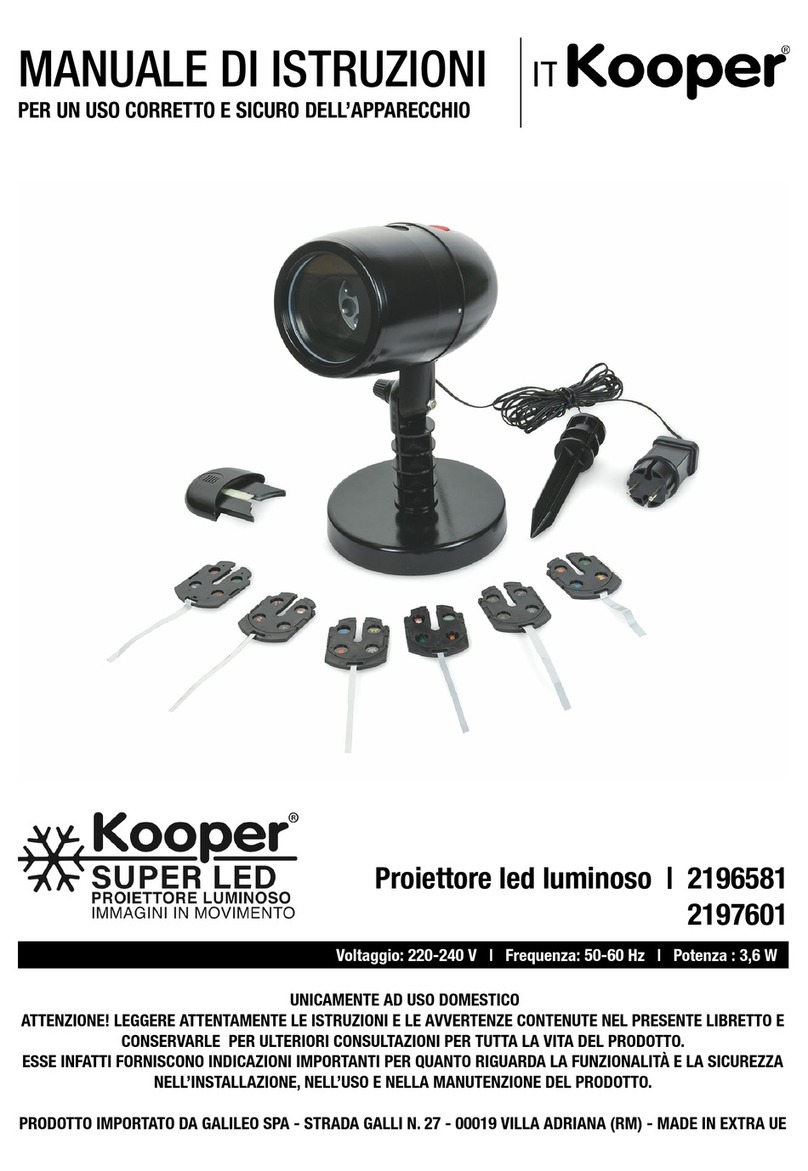
Kooper
Kooper 2196581 User instructions
